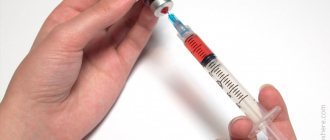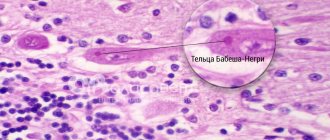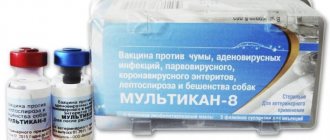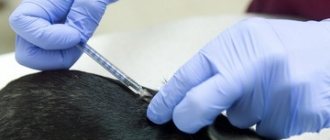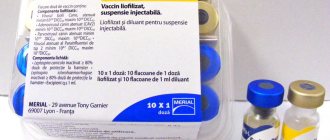Any living creature can get rabies, be it a wild animal, a pet or a person. This is a very serious and dangerous disease, which is almost always fatal. A living organism does not have its own immune response to rabies, so vaccination is necessary to prevent infection.
This is the only disease whose prevention is strictly controlled at the state level. There is even a special law on this matter. Therefore, it is mandatory for dogs to be vaccinated against rabies.
Characteristics and danger of rabies
The causative agent of rabies is the rhabdovirus family, which affects the central nervous system. As a result of infection, the animal experiences damage to the nerve endings and gradual failure of the spinal cord and brain.
The main symptoms of this dangerous disease include the following:
- hydrophobia (refusal to drink, uncontrollable fear at the sound of dripping water);
- aggressive or apathetic behavior;
- copious foamy saliva caused by a violation of the swallowing reflex;
- perverted appetite (eating inedible objects).
A sick dog must be isolated in a separate room and not contacted until the veterinarian arrives. The virus is equally dangerous for all warm-blooded animals, including humans. In the final stage, it causes laryngeal paralysis or cardiac arrest.
In the absence of vaccination and the appearance of at least one of the listed symptoms, the chances of salvation are close to zero. Due to the lack of a cure, the only humane solution is euthanasia.
Vaccines for dogs against rabies
Mandatory vaccination is established at the state level. Without a note in the dog's passport about vaccination, it is impossible to participate in exhibitions. And also, customs does not allow such animals through; they can forcibly confiscate them and vaccinate them.
In some countries, there is criminal liability for failure to vaccinate animals. This is taken very seriously all over the world; you should not vaccinate your animal on time to protect yourself and save the life of your pet.
The following types of vaccines are used in the Russian Federation:
- Nobivak Rabies is a Dutch-made product that belongs to the category of those that do not contain a live pathogen. Its uniqueness lies in the possibility of using the vaccine as a solvent for other Nobivak vaccinations, which makes it possible to immediately protect the animal from several diseases;
- Rabix - also belongs to the category of vaccines that do not have a live pathogen; use is allowed from eight weeks of a pet’s life. A distinctive feature of the vaccine is that it is a secondary revaccination of the first vaccination of animals. It is carried out after 21 days, then every year the animals are vaccinated once;
- Dohivac is a Dutch-made drug that also does not contain a live pathogen and is similar in characteristics to Nobivak;
- Febrivac 3 plus is a drug of German origin, without a live pathogen in its composition, similar to Nobivak.
Before choosing a vaccine, you should consult with a veterinary clinic, study reviews both on the Internet and from pet owners and professional breeders. Choosing the right vaccine will keep you and your pet safe.
If you plan to breed, you must first prepare the dog so that the pregnancy is easy and without complications. A month before pregnancy, bitches are vaccinated against viral infections, dewormed, and protected from insects. Is a rabies vaccination necessary for a pregnant dog? Of course, all doctors believe that it is necessary to vaccinate the dog before a planned mating.
If pregnancy occurs, it is recommended to vaccinate the dog in the first third of pregnancy, that is, 19–21 days after mating. It is necessary to read the instructions carefully; the manufacturer indicates whether there are any contraindications such as pregnancy. You should refuse vaccination if your dog is having a hard time with pregnancy. The vaccine is more likely to provide protection to the mother than to the puppies, since it then takes time to develop immunity.
Why is vaccination so important?
Regular vaccination of pets is necessary to reduce the epidemiological burden in cities, so every responsible owner must follow the vaccination schedule. This procedure is the only effective way to prevent rhabdovirus infection.
After vaccination, no more than 2-4% of animals become infected. But even with such an unfavorable outcome, the mortality rate is almost zero. A vaccinated dog with suspected infection is vaccinated again to increase the body's resistance.
In order not to die, you need to know everything about rabies
In order for you to find out the answers to all your questions, you will have to dive deeper into the topic. Well-known veterinary medicine (veterinary medicine) is an area of scientific knowledge and practical activity aimed not only at combating animal diseases, but also at protecting people from zooanthroponoses , producing sanitary-quality animal products and solving veterinary and sanitary problems of environmental protection.
Zooanthroponoses are diseases common to animals and people, in which the source of pathogens for humans is our little brothers. That's why…
The main goal of combating the rabies virus among animals is primarily to protect people!
Russian legislation
Vaccination against rabies in dogs is included in the mandatory list of vaccinations in Russia. Unvaccinated pets are prohibited from traveling abroad, participating in exhibitions and breeding. They may also be refused admission to some veterinary clinics, citing an increased risk of infection.
Thanks to its consolidation at the national level, the vaccine is administered completely free of charge. This service is provided by regional government clinics. Please note that this social program only applies to vaccines containing rhabdoviruses. Vaccination against other infectious diseases is carried out only on a paid basis.
How and where to give the injection
Before giving the vaccination, the veterinarian examines the dog and takes the temperature. If she is healthy, the vaccine is injected into the withers under the skin. Some serums can be administered intramuscularly.
Next, a note is made in the pet’s veterinary passport indicating: the name of the drug, the date of administration. The seal of the veterinary clinic is affixed.
If the owner wants to vaccinate his dog at home, it is better to arrange such a service with a veterinarian in advance. Do not forget that the doctor’s visit will be paid according to a separate price list.
Routine rabies vaccination at a government agency is provided free of charge.
Contraindications
There is a list of animal conditions when rabies vaccination is contraindicated for it:
- increased body temperature;
- there are worms;
- immunodeficiency;
- underweight;
- presence of diseases;
- individual intolerance to the administered drug.
Some veterinarians recommend very carefully administering rabies serum to individuals over 10 years of age. Such advice is given because there is a considerable risk of unpleasant consequences in the body.
How animals are vaccinated
When vaccinated, four-legged patients are injected with weakened or dead fragments of the viral code, which stimulate the production of T-lymphocytes. Thanks to these antibodies, the immune system not only destroys the invading pathogen, but also remembers how to fight the infection. In the future, this allows the production of protective cells without additional stimulation immediately after infection.
Over time, the immune response weakens. For this reason, the vaccinated animal is revaccinated or re-vaccinated.
When is the first vaccination given?
Passive immunity acquired from the mother deteriorates at approximately 2 months, when breast milk production stops. From this moment on, the baby begins to be vaccinated. The rhabdovirus vaccine is administered last, when the puppy approaches 3-4 months of age.
Adjustment of the recommended period up or down is possible in the following cases:
- copious amounts of milk with a small litter;
- diligent avoidance of places with large concentrations of animals;
- no need to travel abroad;
- early weaning from mother;
- crowded content;
- there is a need for urgent relocation;
- a sudden outbreak of an epidemic in the area.
The maximum period of grafting is 6-9 months. Please note that puppies under 2 months of age are rarely vaccinated, as their bodies do not always produce a strong immune response. This is due to the presence of passive immunity that has not yet weakened.
Revaccination schedule
If the drug is introduced too early, revaccination is carried out after 3-4 weeks, and with the standard one - only after 1 year. All subsequent revaccinations are carried out annually - or once every 3 years. The latter option is suitable for animals with weakened immune systems and chronic diseases.
Pros and cons of vaccination
Not all owners carry out annual prophylaxis for their animals; some do not know about its existence. Some animals spend their time at home, but this does not exclude the need to protect them from environmental influences. Vaccination of dogs is aimed at overcoming the risks of diseases, including rabies.
Therefore, owners should not be faced with the question of whether to vaccinate. The likelihood of contracting rabies is quite high; in many countries of the world, the obligation to vaccinate an animal is fixed at the state level, which implies liability in case of evasion of regulations.
There is no reason why you should be against vaccination. It will not only save the lives of you and your pet, but also avoid problems if other people are bitten by your pet. If vaccination is not carried out and the dog becomes infected with rabies, at the legislative level such animals are euthanized.
Vaccination by all breeders and owners will significantly reduce the impact of the virus on the environment. The only disadvantage may be individual intolerance to some components of the vaccine, but this issue must be resolved with a veterinarian and alternative active drugs must be used.
Preparation for the procedure
The main cause of complications after the procedure is non-compliance with recommendations for preparation and post-vaccination quarantine. 2 weeks before the event you need:
- Regularly measure temperature and monitor stool quality. The appearance of alarming symptoms is a serious reason to postpone vaccination, so be sure to make sure that your pet is completely healthy.
- Stick to your usual diet, avoiding introducing new foods. You will only have to refuse food 4 hours before the start of the event.
- Treat against ecto- and endoparasites. In case of direct infection, the date of the procedure will have to be postponed.
Special care will be required when preparing the puppy. Before vaccination, the baby is prohibited from contacting other animals and people dressed in outerwear and street shoes.
Contraindications
Regardless of the type of vaccine, there are contraindications common to all of them:
- Puppies younger than three months of age should not be vaccinated. But this recommendation applies only to prosperous areas. If the situation with rabies in a particular region is critical, the sooner the animal is vaccinated, the better for both it and its owners.
- Sick and weakened animals should not be vaccinated. They still need to be vaccinated, but only after the pet has returned to normal physical shape. The vaccine itself is not at all dangerous for dogs under any circumstances. The problem is that the body of a weakened dog is not able to form normal immunity.
Vaccine selection
Anti-rabies drugs for dogs differ in the manufacturer and the number of viral code fragments they contain. According to the first criterion, they are divided into domestic and foreign, and according to the second - into mono- and polyvaccines. Each of them has its own advantages and disadvantages, which you should familiarize yourself with in advance.
Nobivac R and RL
The Dutch Nobivak is recognized as the best rabies vaccine for dogs. It is produced in the form of monovaccine Nobivak R and polyvaccine Nobivak RL. In the second case, the vaccinated animal receives protection not only from rhabdoviruses, but also from leptospira.
A monovaccine is a more gentle drug that promotes the high-quality production of antibodies to a specific infection. When a polyvaccine is administered, antibodies to different diseases can suppress each other, but this phenomenon is typical with a multicomponent composition of 6-7 elements. Nobivak does not have such a problem, so for shy pets who cannot stand people in white coats (to avoid frequent trips to the clinic), you can safely choose Nobivak RL.
Biocan
This polyvaccine is produced in the Czech Republic. In addition to rabies, it protects against infectious hepatitis, parvovirus enteritis, parainfluenza, canine distemper, adenovirosis and leptospirosis. As many as 7 components fully explain the fact that dogs vaccinated with Biocan often develop one of the listed diseases. Most often, the antibodies responsible for fighting parvovirus are suppressed.
Rabiks
Rabix is a domestic mono-vaccine, attractive at a low price. It's hard to find any reviews on it. But this is precisely why you don’t have to worry about possible side effects, because in most cases, owners always share their negative experiences on the appropriate forums. But the positive aspects are often missed, taken for granted.
Rabizin
The French drug Rabizin gives a fairly stable immune response, lasting almost 3 years. It is recommended for dogs weakened by chronic pathologies and pregnant bitches. The only drawback is the periodic occurrence of allergic reactions. For this reason, after vaccination, it is recommended to stay at the veterinary clinic for at least 30 minutes.
Rabikan
Another Russian mono-vaccine offered in state veterinary clinics. Despite the rather strong side effects, it gives a quick (within 5-7 days) and persistent (up to 2 years) immune response.
Defensor 3
The American monovaccine Defensor-3 is often used in combination with the drug Vanguard Plus from the same manufacturer. Depending on the epidemiological situation, it is administered annually or once every 3 years. Some dogs may experience an allergic reaction.
First aid for humans and dogs after being bitten by a suspicious animal
First aid for a person and a dog after a bite is to mechanically remove the pathogen that has entered the wound, so immediately after the incident :
- the one who will provide first aid must wear any rubber gloves;
- you need to wash the bite site for a long time and intensively using soap under running water;
- during washing, it is advisable to deliberately squeeze blood out of the wound;
- after thorough rinsing, dry the wound and liberally apply any antiseptic (alcohol, vodka, miramistin, etc.) to destroy any virus that may have entered;
- be sure to apply a bandage over the wound (you cannot cauterize the wound or apply stitches yourself);
- immediately contact the nearest emergency room (for humans) or veterinary clinic (for animals) - the longer it takes the bitten person to get to a medical facility, the higher the likelihood of contracting rabies;
- It is imperative to carry out a therapeutic course prescribed by a doctor.
The rabies virus is very unstable, therefore, well-provided first aid and timely treatment, as a rule, prevent the development of rabies in humans.
For dogs and cats, the risks of contracting a fatal disease still remain high , since even an unscheduled introduction of a rabies vaccine does not provide 100% protection in this case, since antibodies may not have time to develop in time to prevent the development of a fatal disease (everything will depend on this). from the incubation period). Therefore, well-provided first aid and preventive vaccination given no more than one year ago play an important role here.
Treatment of rabies. Help after a bite.
Basic human treatment
Treatment of a person will be effective only in the period BEFORE the first signs of rabies appear. If you seek medical help only at the first signs, then the treatment will be ineffective, and this means 100% death.
Unfortunately, there is no anti-rabies therapy that can cure a person after symptoms appear. Hence the conclusion - the first aid provided and anti-rabies therapy from the first day of injury will play a huge role.
The main treatment of people is carried out according to a strictly approved protocol and under the strict supervision of a doctor. Fortunately, it is no longer necessary to take 40 injections in the stomach. Nowadays, more modern drugs are used in medicine - rabies immunoglobulin and rabies vaccine (rabies vaccine). Currently, anti-rabies therapy includes only 6 injections in the shoulder area (deltoid muscle) and thigh.
Features of human treatment
It should be borne in mind that these are not strict patterns of care, since the doctor can prescribe a regimen individually for a particular person, after weighing all the facts.
When an unvaccinated dog that has bitten a person is available for observation for 10 days (lives at home or with a neighbor), then initially the person is given only 2 injections of the rabies vaccine. It is also necessary to treat the wound (bite site) with anti-rabies immunoglobulin. If the dog does not show symptoms of rabies during these 10 days, then the human treatment ends there, since both are not infected.
However, if the dog is unavailable for observation (street) or it dies in a short time, then the person who managed to seek help in the first three days after the bite is immediately injected with rabies immunoglobulin, and then immediately with the rabies vaccine, but in a different place.
If you are bitten by a dog that was vaccinated no later than a year ago, then first of all you need to compare the facts - the behavior of the dog or cat in general, whether the pet intentionally bit a person or whether this action occurred because it was teased, etc.
In any case and if you have any doubts, be sure to visit a doctor! Remember, there is no cure for rabies, but you can prevent its development.
For people with obvious signs of rabies, it is only possible to alleviate the suffering as much as possible by using sedatives, administering drugs against seizures and installing a tracheostomy with further connection of the patient to an artificial respiration apparatus. Tracheostomy is the insertion of a special tube into the trachea to ensure air flow into the respiratory tract.
Is it possible to get an anti-rabies vaccine yourself?
Despite the simplicity of the procedure, self-administration of the drug should be avoided. Otherwise you risk:
- Violate the conditions for transportation, storage and use of the vaccine, which threatens a decrease in effectiveness and complications.
- Be left without a veterinary passport. This important document is issued only in veterinary clinics.
- Losing a pet due to a sudden attack of anaphylaxis (allergic suffocation). It is almost impossible to cope with an acute allergic reaction at home, so you should not risk your pet’s health.
Remember that before vaccination you need to undergo diagnostics. This is necessary to exclude hidden diseases that complicate the development of an immune response.
Reaction to rabies vaccination in dogs
Despite vaccine manufacturers' promises that they will not cause side effects, complications can occur in any dog's body.
The injection site is often accompanied by the appearance of a hard, round swelling. Skin thickening and slight heating of the injection site are observed. If there is no increase in density and no pain when touched, there is nothing to worry about. After 15–22 days, the lump will resolve on its own.
The first 10–12 hours may be accompanied by a slight increase in temperature, decreased activity, digestive disorders, and a weak reaction to external stimuli.
Post-vaccination period
The duration of this period takes 2-3 weeks. During this time, it is recommended to reduce physical activity, increase the comfort of housing and minimize contact with the outside world.
What condition will the dog have?
Everything here is very individual. Some pets retain their activity and appetite, while others suffer from side effects for several days. The owner can only monitor the pet’s condition, preventing the occurrence of life-threatening complications.
Quarantine
Going outside is allowed only on the 4th day after revaccination. At this point, the likelihood of infection from other animals is minimized, since the body has time to produce protective antibodies. Give your pet a rest and do not burden him with following commands.
After the first vaccination, puppies are kept within the walls of the house for much longer - 14-15 days. This is the only way to protect the baby from the negative effects of the external environment.
In addition to walking, it is recommended to avoid swimming, as any draft can lead to a cold. Also, do not get the injection site wet.
During the quarantine period, you should avoid introducing new products to avoid an allergic reaction. The move will also have to be postponed. Traveling to a new place of residence will be safe only a month after vaccination.
Contraindications to rabies vaccination
Every animal needs to be vaccinated; it is important to know when to do it. Regardless of the type of vaccine, there are general contraindications that every owner needs to be aware of:
- It is worth vaccinating a puppy only after it reaches three months; early vaccination is contraindicated in all cases, except when the pet lives in a disadvantaged area with a strong spread of the disease;
- If the animal is sick and weak, it will not allow it to form normal immunity to pathogens, so the vaccine may be ineffective.
The vaccination itself does not cause any harm.
Complications and side effects
The canine rabies vaccine causes a temporary decrease in immunity. Because of this, the following side effects may occur soon after the procedure:
- decrease and loss of appetite during the first day;
- temperature rise within 39.5°C and loss of activity for 3 days;
- pain and temporary lameness, disappearing after 4 days;
- a single attack of vomiting or diarrhea;
- the appearance of a small lump at the injection site, which resolves on its own within a month.
The help of a veterinarian will be required only if the pet’s well-being deteriorates, the lump suppurates and grows, as well as an acute allergic reaction. An attack of anaphylactic shock is easily recognized by swelling and pallor of the mucous membranes, profuse salivation and difficulty breathing. If these symptoms occur, the animal should be given an antihistamine and urgently taken to the nearest veterinary clinic.
Types of vaccines and their costs
Rabies vaccines are predominantly single-component, since the timing of administration according to the vaccination calendar differs from most other viral diseases for which cats are vaccinated.
Table: popular rabies vaccines for cats
| Name | Manufacturer | Vaccine type | Release form | Cost per dose |
| Defensor-3 | Zoetis LLC, USA | Monovaccine with inactivated rabies virus | Suspension for injection | 120 rubles |
| Nobivac Rabies | Intervet International BV, Netherlands | Monovaccine with inactivated rabies virus | Suspension for injection | 150 rubles |
| Rabizin | Merial, France | Monovaccine with inactivated rabies virus | Suspension for injection | 150 rubles |
| Quadricate | Merial, France | Complex vaccine for cats against distemper, herpes, calicivirus and rabies. The rabies virus in the drug is inactivated. | A dry white mass in a bottle, representing a mixture of rabies and distemper viruses, and a separate bottle with a solution of herpes virus and calicivirus. | 700 rubles |
Photo gallery: rabies vaccines for cats
Quadricat is a multicomponent vaccine that protects a cat from 4 diseases at once (rabies, panleukopenia, calicivirus and herpes)
Nobivac Rabies is an anti-rabies vaccine for warm-blooded animals, produced in the form of a ready-to-administer suspension
The Defensor-3 vaccine, produced in the USA, is single-component, that is, it protects the animal from only one disease - rabies.
Rabizin is an anti-rabies vaccine for cats that contains an inactivated virus that causes the disease.
Reviews of rabies vaccines
Both dogs and cats are vaccinated with the nobivac rabies vaccine. I have two cats, we vaccinate them as required once a year in the spring. Wherever you vaccinate, there is a risk of a “ball” forming under the skin at the injection site; there is nothing wrong with this if the animal behaves normally. Don’t press it, just keep an eye on it; in a couple of months, for us personally, everything will resolve itself. My cats tolerate the vaccination well, as if nothing was happening. The doctor removes the veterinary passport sticker from the cone, pastes it on the appropriate column, puts the date of vaccination and the clinic stamp.
rovione
https://irecommend.ru/content/doveryaem-1
Our eldest cat is already 6 years old. His first vaccinations were given with the Quadricat vaccine. from Merial. This is a French company. Previously, we did not know what exactly a good vaccine was. Therefore, the doctor decided at his own discretion. Then they started using Vakderm (Polivak and Purevax were also recommended). The cat tolerated the vaccination well. I was feeling great, I was moving actively, I had an appetite. There was no goose at the injection site. Everything went well. So I recommend it!
Evelina2622
https://otzovik.com/review_3879300.html
On Saturday, November 1, 2015, all cats (those who were healthy) were vaccinated against rabies with Defensor. During the 5 days of observation, everyone felt excellent, there were no problems. Cats have good immunity for a year; according to research from those clinics that are involved in processing the travel of animals abroad, it is the Defensor vaccine that gives high titers in the study. In general, we recommend it for cat owners to use before the start of the summer season))))
Shelter Valenta
https://vk.com/wall-15237006_7099
Forms, stages of rabies
Rabies has several stages of development and occurs in cats in different forms, each of which has its own symptoms.
Forms of rabies in cats:
- Easy. The duration of the incubation period is from three to five days to 1-3 months. The animal's behavior changes. Cats become overly affectionate, annoying, and require increased attention from their owners. Attacks of affection are replaced by a state of panic. The pet is afraid of noise, sharp sounds, bright light, reacts inadequately to stimuli, and hides in secluded places. Foamy salivation, difficulty swallowing, disturbances in heart rhythm, breathing, and muscle spasms are noted.
- Violent. The most commonly diagnosed form of hydrophobia in cats. The pet shows aggression, disobedience, does not cooperate, refuses food due to spasms of the laryngeal muscles, and loses weight. The fur is tousled, dull, and falls out in clumps. The pupil does not react to light. The lower jaw droops. Saliva flows from the mouth. Anxiety gives way to complete apathy. The temperature is normal or elevated at the beginning of the development of infection or within the normal range. Paralysis of muscle structures develops, and the pet suffers from epileptic seizures. The cat dies from exhaustion, severe intoxication, and respiratory failure.
- Atypical. This form of hydrophobia is rare. The first symptoms, which are similar to manifestations of gastroenteritis (vomiting, diarrhea, high fever, loss of appetite, exhaustion, discharge from the eyes and nose) may appear 3-7 months after infection. In this condition, the cat's condition is changeable. Symptoms subside for a while, after which they appear again. The pet dies.
The first symptoms that allow you to understand that a cat is infected with the rabies virus are inappropriate behavior. If you suspect an infection, take the cat to a veterinary hospital until it is examined and an accurate diagnosis is made.
At what age can cats be vaccinated?
The first vaccination is given at 3 months, unless there are indications for earlier vaccination or, conversely, contraindications. This period is due to the fact that the kitten’s body contains antibodies received from its mother, and only from 8 weeks their level decreases. There is a risk of infection from the first days of life, but it is not advisable to vaccinate a newborn kitten - antibodies transferred from the mother destroy some of the microorganisms introduced with the drug, and its effectiveness decreases. Therefore, the optimal age for rabies vaccination in cats is 3 months. If vaccination was carried out earlier than 3 months, it is repeated in due time. It is acceptable to vaccinate pets at 4-5 months.
As is clear from the above list of drugs, each has its own characteristics and duration of action. But, mainly, the vaccine is administered once, and revaccination is required every year.
